I recently made a brief one week visit to the Masai Mara with a colleague from work. No rock cams this time as this is very much an individual pursuit involving long hours of waiting and no small measure of patience, more often than not culminating in frustrating results. As this was my friend’s first visit to the Mara, I wanted to show him what all the fuss about the Mara is during migration season. After a slow start, our luck turned towards the end of the week with a particularly unique sighting.
The Mara in August through October is all about the Wildebeest migration. In a good year, well over a million of these awkward looking herbivores spill into the Mara accompanied by equally impressive numbers of Zebras and other grazers. The distribution of local rains in the Northern Serengeti and the Mara is generally the key factor determining when the herds arrive and in what numbers.
This year the migration arrived unusually early – in June. However, the size of the herds so far has fallen short of previous years and as I write this, I would estimate that less than half of the entire migration has entered the Mara. Still, the migration is in a constant state of flux and a few days of heavy rains in the Mara could change all this.
The main river crossing points adjacent to the Serena Lodge are proving disappointing this year. Firstly, most have involved crossings into the Mara Triangle – i.e. away from our vantage point (you always want the herds coming towards you). In addition, a mass drowning at the aptly named Cul-De-Sac crossing has meant that the waters of the main crossing points are littered with carcasses. As a result the Nile Crocodiles are paying little attention to the herds as they traverse the river. Moreover, with the waters swollen from abundant rains earlier in the year, the few attacks that do take place are over in a few seconds with victims quickly drowned.
In the image below, a Topi is shown trying to find the exit point amid the impassable vertical banks at Cul-De-Sac.
Meanwhile though, the crossings have been a little more productive down in the South Mara. Not only have there been more crossings from the Triangle into the conservancy areas but the steeper banks at the key crossing points at this stretch of the Mara River provide a more photographic spectacle relative to the corresponding points in the Northern Mara.
There are fewer Crocs in the South Mara vs. the multitudes at the main crossing points but we did see this attempt at the bank as these Zebras were drinking prior to crossing.
Not more than five minutes later, we saw the same Croc take a young Wildebeest from the exact same spot – alas, no good pictures.
As we were driving away from a crossing one morning, we spotted a Hyena running at full tilt but with a dark object hanging from its jaws. At first we thought it was a piece of Wildebeest carcass but after following it and getting closer, it quickly became apparent that it was in fact a small Hyena pup. Adult Hyenas often carry young pups from den to den as recently born pups are apt to wander off in the wrong direction out in the open where they are also vulnerable to various predators, especially Lions. Sadly, it also became evident that this pup was dead. Why the mother was running so frantically and how the pup died, remain a mystery. Perhaps the mother gave birth to a still born pup, perhaps it was killed by a rival Hyena and perhaps the mother’s frantic running was simply due stress. Everyday in the Mara one sees behavior which cannot be explained and which one can only speculate on.
I did manage to take this close-up image as the Hyena ran parallel to our vehicle with the lifeless pup hanging gently from her jaws.
Cheetahs are the rarest of the big cats in the Mara, but this year there are unusually large numbers of these graceful felines on the grass plains. In a small area on the way down to a conical hill known as “Lookout”, we found: 1) “the three boys” – three adult male Cheetah brothers with exceptional hunting skills who have been swaggering across a large area of the Mara for the last three years; 2) the famed “Mrembo” female Cheetah who currently has a large sub-adult cub in tow; 3) a solitary female Cheetah; 4) a first time Cheetah mother who appears to wander aimlessly across the plains trailed by her two, often exhausted, young cubs and 5) best of all, an experienced female cheetah with six (yes six!) small cubs. We only found this menagerie on our last day and the harsh light of the middle of the day prevented us taking any decent images but while the odds are slim, if she can keep these cubs alive, they will surely provide millions of unforgettable photo opportunities for the Mara’s numerous visitors.
Although Lion numbers have decreased significantly across Africa over the last three decades, the Mara remains a key stronghold for the species with several prides continuing to thrive.
Early one overcast morning, we found a young Wildebeest that had lost its mother and had become separated from the herds. We followed it for several minutes as it approached a series of Crotton bushes leading to the banks of the Talek River. This area is home to a large, dispersed pride of Lions that we had seen in this exact area the previous day. Sure enough, we soon spotted three adult Lionesses resting under some small bushes. At first it appeared the Wildebeest would avoid them but inexplicably it changed direction and doubled back on a path that would take it directly past the Lionesses. We positioned our vehicle in sight of both predator and prey. As the Wildebeest came into view, one of the Lionesses inched forward, assuming a classic, low stalking position. As soon as the Wildebeest had jogged past it, the Lioness exploded out of the bushes. The Wildebeest veered sharply, galloping desperately towards our vehicle with the Lioness quickly gaining on it. The chase, which lasted no more than a few seconds, took place so close to our vehicle that our long lenses were rendered useless.
A trip to its back legs sent the Wildebeest sprawling in a cloud of dust. As soon as it regained its footing, the Lioness was on its throat. We just had time to reposition the vehicle, switch to a shorter lens and fire off a few shots before the Wildebeest’s legs gave way and it seemingly succumbed to the Lionesses’ death choke.
You always witness these events with mixed feelings – elation on the one hand at witnessing what is still a rarely seen event and being in the right position to get some decent images, but on the other hand, sadness and sympathy for the poor Wildebeest. In this case, these emotions were amplified as the Lioness did not in fact kill the Wildebeest. Instead it waiting for the rest of the pride to arrive at which point it released the Wildebeest to the sub-adult cubs. Lacking experience, they were unable to put the Wildebeest out of its misery and it was left to the other adult Lionesses in the pride to eventually end its suffering.
On the subject of suffering, we were resting up one day under a large Acacia tree in the mid-day heat when a solitary, limping Wildebeest ambled by. Through our binoculars we could see that it had broken a leg. How this had happened is unclear although most likely it would have occurred on the steep and often slippery banks leading to/from the Mara River. Whatever the cause, its prognosis was a near 100% certainty of death within the next 24 hours. Without the ability to run it would surely be picked off by Lions, Leopard, Hyena or even the three Cheetah brothers.
We drove over to take a closer look. It made no effort to move from the partial shade that it had found so opening the vehicle door and with a camera in hand and arms extended, I was able to take this wide-angled shot.
Ostriches are common enough in the Mara but are always highly photogenic. We found this male sitting on an egg so he was easy to approach as we knew it would take a lot to spook him from his incubation duties. This is a somewhat unusual angle of the long necked bird. Ideally, I would have preferred both eyes visible but I still like the hairs on its neck and the single, red eye.
Leopards are the most numerous of the big cats in the Mara but the hardest to see. This is partly because they are most active at night but mostly because they are extremely secretive and shy creatures. However, the Mara has typically always had up to a handful of Leopards that are highly tolerant of vehicles and relaxed at showing themselves during the day. In years gone by, one such Leopard was the Bella, star of the Big Cat Diary series. She in turn produced a daughter, Olive, who is also incredibly comfortable with vehicles. Olive has now produced her own offspring, one of which is a young male called Paja.
Although Paja will eventually grow to a size that will make him considerably larger than female Leopards, he is currently a little smaller than his mother. He also still lacks the necessary hunting skills to regularly take down the standard Leopard quarry of Impalas, Gazelles and Wildebeest.
While he is still occasionally sharing his mother’s kills, he is now perfecting his hunting abilities by focusing on smaller and sometimes highly unusual prey. In particular, he seems to have developed a taste for Monitor Lizards.
For those of you who have not seen a Monitor Lizard, it looks like a smaller version of a Komodo Dragon. However, adults can reach lengths of five feet and have a distinctive upper set of sharp teeth set amongst powerful jaws. They are carnivorous and recent studies suggest that they may be capable of producing venom.
Late one afternoon our guide received a call on his two way radio that a Leopard had been spotted not far away killing a Monitor Lizard. We quickly drove to the spot, just in time to see Paja carrying the now deceased Lizard up a grassy bank.
Two days later, the same event was repeated. This time we had been following Paja as she flitted in and out of the Crotton bushes, in the process making a number of unsuccessful attempts on Spring Hares and various birds. She then disappeared behind some rocks set within a dry river bed. At this point we thought we were in for a long wait given that Leopards, as with all the big cats, can spend many diurnal hours simply doing nothing.
After approximately 30 minutes, we became aware of a commotion behind some rocks in a position some distance from where we had last seen him. Shortly after, he emerged with an enormous Lizard clamped between his jaws. With pulses racing, he then answered our prayers and dragged the still struggling reptile onto a group of exposed rocks approximately 30 meters from our vehicle. Although clearly the worse for wear, the Lizard was still struggling with its jaws periodically opening and closing and its tail thrashing around. This only ceased after a prolonged bite from Peja to the Lizard’s throat. After a period of licking and almost playful biting, Peja eventually dragged the now motionless Lizard to the top of a concealed rock well away from our vehicle.
It was an exhilarating experience and will go down as one of my best ever wild encounters. While you never know for certain, I doubt I will witness such behavior again.
On our last night while driving back to camp, we found two male Lions lying in some long grass. Occasionally they would raise their heads and this alerted a small herd of nearby Zebras to their presence. With the Zebras focused on the Lions, we were able to drive up reasonably close to them with the added bonus that they were all motionless and also looking the same way. With the camera balanced on a beanbag and using filters to balance the darker foreground with the lighter background, I was able to take this simple but pleasing image. I really like the composition and the hint of pastel colours in the sky.
It is rare that the Mara fails to deliver something special over the course of a week and hopefully I will have more luck when I return in late October.
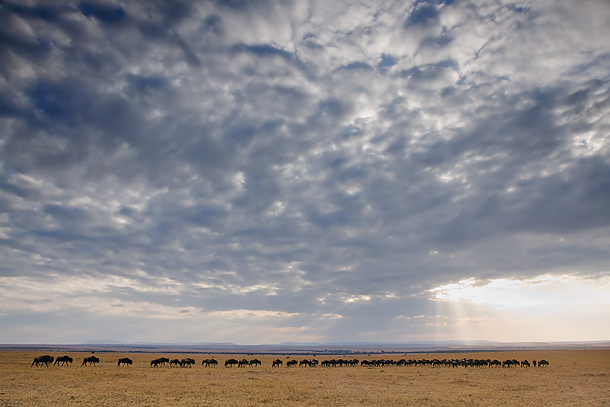
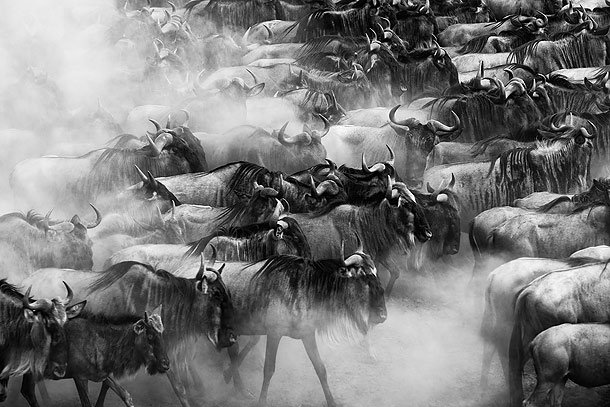
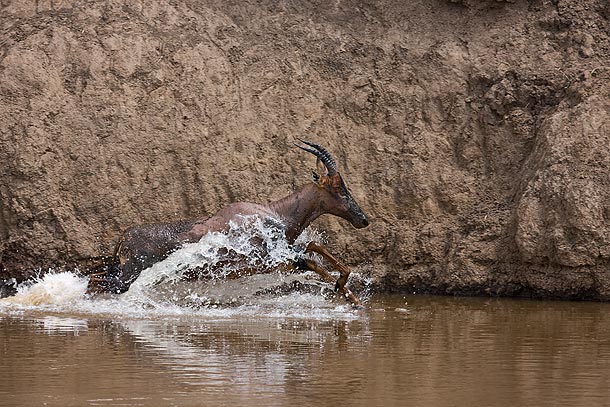
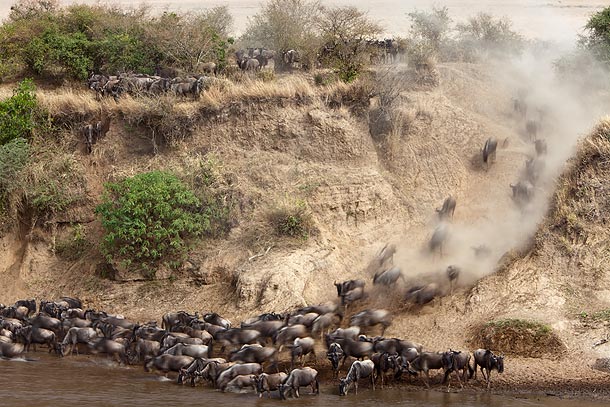
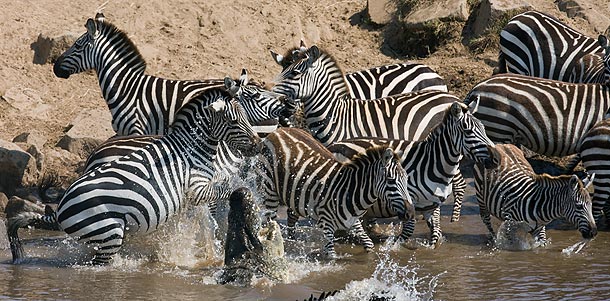
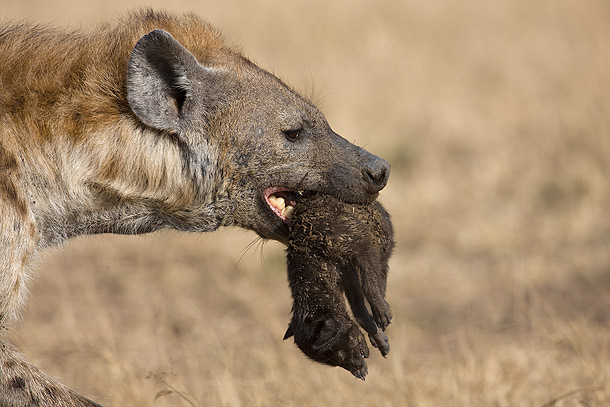
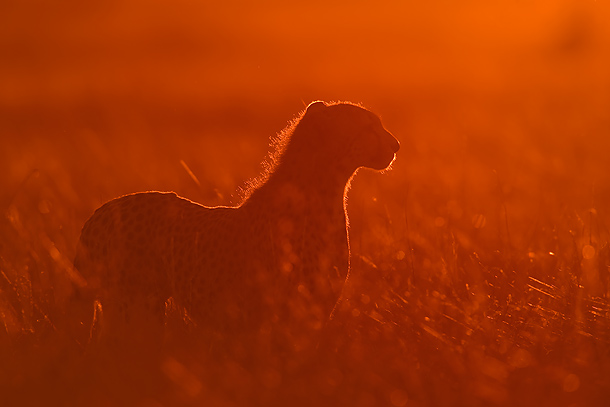
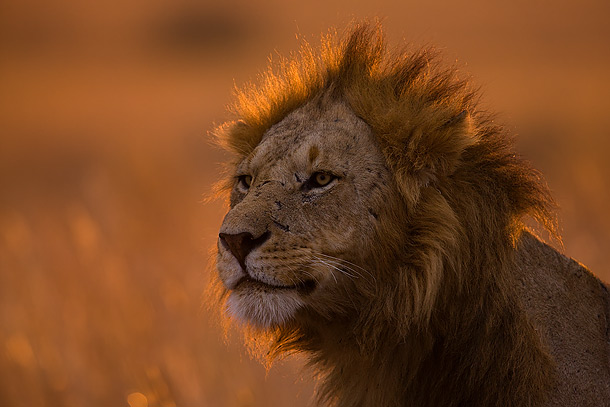
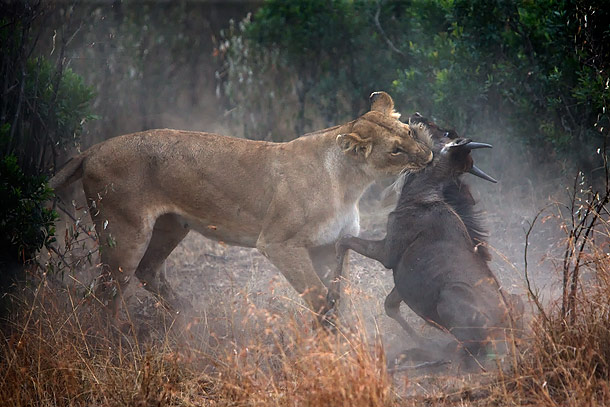
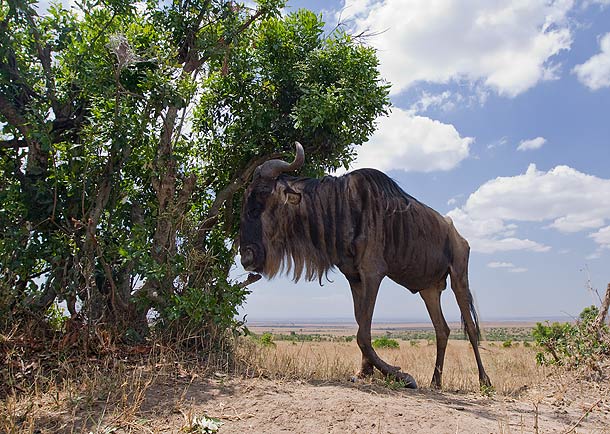
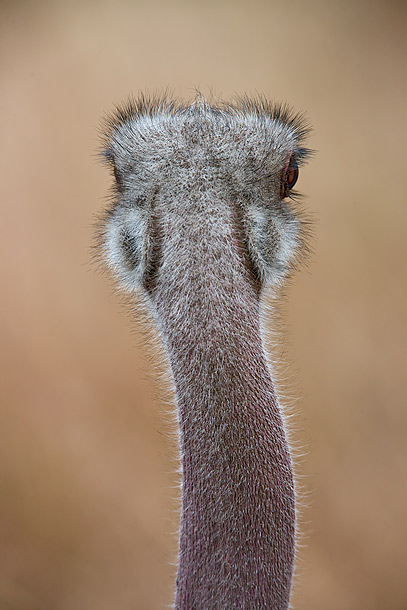
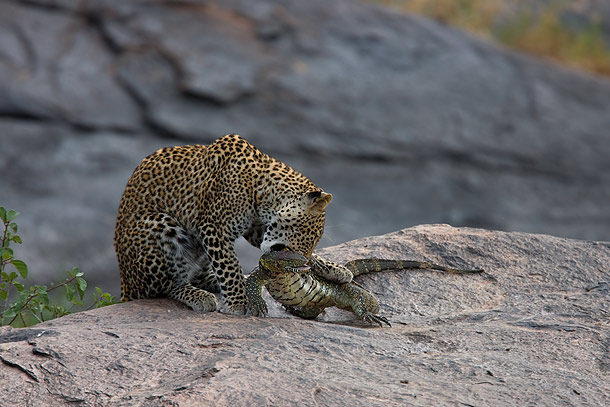
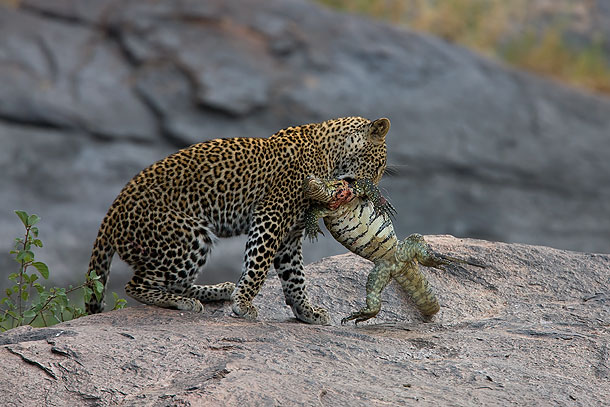
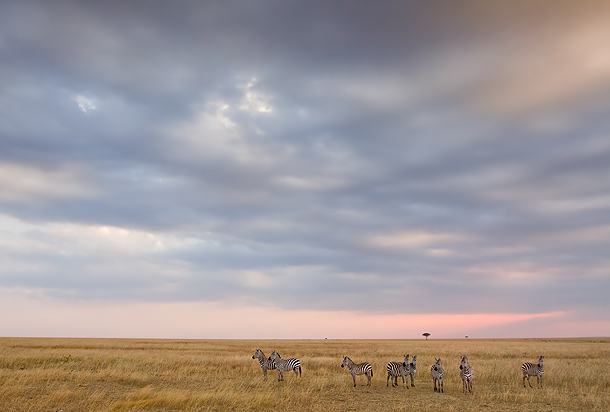
Grace Wong
August 25, 2010
breathtaking. esp love the ones of the wildebeest charging down the river & the B/W shot
Yan Verschueren
August 26, 2010
Amazing pictures.!! Not only the rare pictures of the leopard and his unusual prey. Live can be cruel but we must understand these surving strategy and accepted it . To be witness of these wildlife actions is an unforgetable experience in a human’s life. Thanks for charing these special moments with us.
Nilla Stennes
August 26, 2010
It is such a pleasure, and a real privilege to be able to view your pictures and read the
interesting comment!
Thanks for sharing!!!!
Gordon
August 26, 2010
Thanks for sharing your images and your commentary, it’s great to see the Mara even though secondhand.
Beryl McKenzie
August 26, 2010
Wish I could be there with you!
c k su
August 28, 2010
Thank you for sharing those amazing pictures.
Dod
September 1, 2010
Tremendous….
Goos van der Heide
September 1, 2010
Really great shots! You’re on the right place at the right time again!
james menjo
September 1, 2010
quite amazing